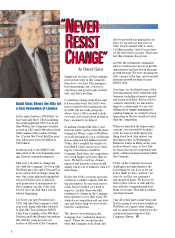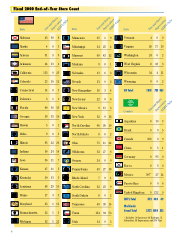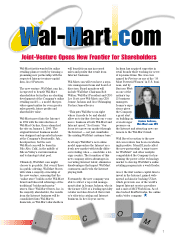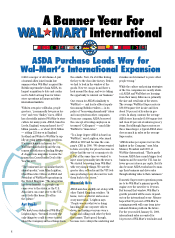Walmart 2000 Annual Report Download - page 10
Download and view the complete annual report
Please find page 10 of the 2000 Walmart annual report below. You can navigate through the pages in the report by either clicking on the pages listed below, or by using the keyword search tool below to find specific information within the annual report.
A Banner Year For
International
Call it a merger of old chums. A pair
of natural allies joined ranks last
summer when Wal-Mart acquired the
British supermarket chain ASDA, its
largest acquisition to date and contin-
ued to build a strong base for future
store operations in Europe and other
international markets.
With its own price rollbacks, people
greeters, “permanently low prices for-
ever” and even “Smiley” faces, ASDA
has cheerfully imitated Wal-Mart’s store
culture for many years. ASDA, based in
Leeds, England, was purchased for 6.7
billion pounds — or about $10.8 billion
— adding 232 stores in England,
Scotland and Wales to Wal-Mart’s rap-
idly growing international operations.
It’s a match made in heaven for
Wal-Mart shareholders and the cus-
tomers of both stores, leading Mergers
& Acquisitions magazine to name the
transaction Cross-Border Deal of the
Year for 1999.
“The businesses are so similar that it’s
almost spooky,” says Allan Leighton,
Chief Executive Officer of ASDA and
President of Wal-Mart’s operations in
the United Kingdom. “The integration
has been fantastic. Our people can
come over to the states, or the U.S.
Associates can come over to the U.K.
and it feels like home. It’s all in
the culture.”
Apt Pupils
“We have been students of Wal-Mart,”
Leighton says, “but until recently the
only things we could do were to read
about the Company and see things from
the outside. Now, it’s a bit like having
the key to the chocolate factory. Before,
we had to look in the window at the
goods. Now we can go in and have a
look around the shop, and we’re taking
the opportunity to reinvent our business.”
One reason for ASDA’s similarity to
Wal-Mart — and for its offbeat reputa-
tion among British retailers — is its
policy of “borrowing shamelessly” ideas
and concepts from other companies.
From one company, ASDA borrowed
the concept of treating employees as
treasured “Colleagues” — much like
Wal-Mart’s “Associates.”
“To a large degree ASDA is based on
Wal-Mart,” says Leighton, who joined
ASDA in 1992 and became the com-
pany’s CEO in 1996. “We always wanted
to have everyday low prices because we
felt we had the sort of economics to do
it. But at the same time we wanted to
inject some personality into the stores.
We started borrowing from Wal-Mart
with very simple things. We saw the
greeter idea, rollbacks and the VPI (vol-
ume-producing item) idea and we took
them back to the stores.”
Maverick Brits
ASDA marches slightly out of step with
other United Kingdom retailers. “At
home, we’re scoffed at and seen as
crazy mavericks,” Leighton says.
“People wonder what we’re doing
knocking all our corporate offices
down, and having everyone wear a
badge and calling each other by their
first names. That’s good, though,
because we’re always the underdog and
it makes us determined to prove other
people wrong.”
While the culture and pricing strategies
of the two companies are nearly identi-
cal, ASDA and Wal-Mart are learning
from their many differences, primarily
the size and retail mix of the stores.
The average Wal-Mart Supercenter is
180,000 square feet in size and does
about 30 percent of its sales in gro-
ceries. In sharp contrast, the average
ASDA store has only 65,000 square feet
and does 60 percent of sales in grocery
items. But although Supercenters are
three times larger, a typical ASDA store
does as much in sales as the average
Supercenter.
“ASDA’s sales per square foot are the
highest in the Company,” says John
Menzer, President and CEO of
Wal-Mart International. “That’s partly
because ASDA has a much bigger food
business and because the U.K. has far
fewer grocery stores per capita. But it’s
also because ASDA works hard to man-
age their business and drive sales
through offering value to their customers.”
Domestic Supercenter operations prom-
ise to be Wal-Mart’s primary growth
engine over the next five to 10 years.
But beyond that window, Wal-Mart’s
growth potential will be more depend-
ent on the international scene. Menzer
hopes that 30 percent of Wal-Mart’s
earnings growth will come from inter-
national division profits in the future.
For the year ended January 31, 2000,
international sales accounted for
14 percent of Wal-Mart’s total sales and
ASDA Purchase Leads Way for
Wal-Mart’s International Expansion
WAL⋆MART
WAL⋆MART
8






















